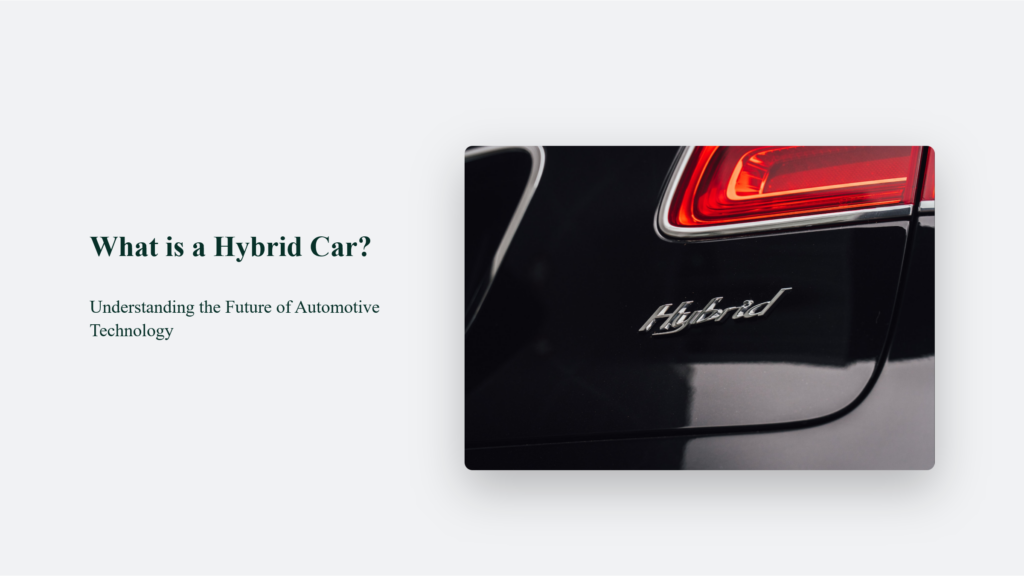

What is a Hybrid Car? Understanding the Future of Automotive Technology

As Seen On
Hybrid cars are like the Swiss Army knives of the automotive world. They’re flexible, efficient, and pack more under the hood than meets the eye. But what is a hybrid car? Let’s dive into the world where gasoline meets electricity and efficiency meets innovation.

What is a Hybrid Car?
Hybrid cars, often hailed as the automotive world’s jack-of-all-trades, blend the reliability of gasoline engines with the eco-friendliness and innovation of electric motors. They’re the go-to choice for those who crave a guilt-free driving experience without the range anxiety often associated with fully electric vehicles.
At the heart of a hybrid car lies a dual-power approach. By combining a traditional internal combustion engine with an electric motor, these vehicles offer improved fuel efficiency and lower emissions than their gasoline-only counterparts. This tandem saves you trips to the gas station and contributes positively to environmental conservation efforts.
When it comes to variety, the hybrid market is bustling with options. Models like the Toyota Prius and the Honda Insight are household names in the hybrid world. However, hybrids are not just confined to sedans; they’ve made their way into SUVs and even luxury vehicles, ensuring a hybrid for every taste and need.
Plug-in hybrids (PHEVs) add another layer to the hybrid experience. They can be charged just like your smartphone and run purely on electric power for distances ranging from 25 to 60 miles before switching to hybrid mode. This feature makes them an excellent stepping stone for those considering a leap to fully electric vehicles.
Despite their many advantages, hybrids come with their own considerations. They typically have a higher initial cost than non-hybrid vehicles, and some may lack the raw performance expected by traditional car enthusiasts. However, they often balance this with lower maintenance costs and potential tax incentives, especially for plug-in models.
Understanding the Heart of a Hybrid: Its Powertrain
The hybrid car’s powertrain is an innovative marriage of an internal combustion engine (ICE) and an electric motor. It’s like a dynamic duo where each member brings their unique strengths. The electric motor is a torque-producing whiz, perfect for quick acceleration, while the ICE is the marathon runner, easily maintaining higher speeds. Together, they deliver a blend of efficiency and performance that’s more economical and environmentally friendly than traditional vehicles. This synergy of power sources enhances fuel efficiency and lowers emissions and running costs. It’s a win-win for both your wallet and the planet.
The Different Flavors of Hybrids: From Parallel to Plug-In
Exploring the world of hybrid vehicles is like stepping into a culinary show of automotive technology, where each type of hybrid serves up a distinct flavour of efficiency and performance. Let’s savour the main courses:
- Parallel Hybrids: These are the multitaskers of the hybrid world. In this setup, the electric motor and the internal combustion engine (ICE) work side by side, either independently or together, to drive the wheels. It’s like having two chefs in the kitchen, each taking turns or working simultaneously to prepare the meal.
- Series Hybrids: The electric motor takes the lead role, driving the wheels. The ICE acts more like a backstage generator, producing electricity for the motor. Imagine a solo chef with a supportive sous chef who’s there just to keep the ingredients (electricity) flowing.
- Plug-In Hybrids (PHEVs): These hybrids offer an extra zest. They operate similarly to full hybrids but with a twist – they can be plugged in to charge their batteries, providing a longer electric-only driving range. It’s like having a meal prep option that allows you to store some dishes in the fridge (battery) for easy access later.
- Electric Vehicles with Range Extender Hybrids: While not technically hybrids, these vehicles deserve an honorary mention. They primarily run on electric power but have a small ICE to recharge the battery, ensuring you’re not stranded when it runs low. It’s like having a backup generator when the main power goes out during a dinner party.
Each hybrid type brings unique benefits, catering to different driving preferences and needs. Whether it’s the versatility of parallel hybrids, the efficiency of series hybrids, the extended range of PHEVs, or the assurance of range extenders, the hybrid world is rich with options just waiting to be explored.
Hybrid Cars: Not Just About Saving Fuel
While it’s easy to think of hybrids as mere fuel-sippers, there’s more to them. They are a testament to human ingenuity, a bridge between the fossil-fueled past and the electric future. They show us that we can also have and eat our cake – performance and efficiency in one package.
Why Go Hybrid? Let’s Count the Ways
- Fuel Efficiency: Hybrids use less fuel, meaning fewer gas station trips.
- Lower Emissions: Hybrids are greener, emitting fewer pollutants than their ICE counterparts.
- Performance: Many hybrids offer a zippier acceleration thanks to their electric motors.
- Incentives: Owning a hybrid can qualify you for tax incentives and other benefits.
But Wait, There’s More: Not Just Cars
When we think of hybrids, we often picture cars. But hybrid technology isn’t limited to four wheels. Bicycles, buses, heavy goods vehicles, and even ships are getting the hybrid treatment. This versatility shows the adaptability of hybrid technology across different modes of transport.
Wrapping Up: The Future is Hybrid
Hybrid cars represent a significant step in our journey towards sustainable transportation. They’re not just a stopgap but a preview of a more efficient, cleaner way of moving around. As technology evolves, who knows what exciting forms hybrids will take next?
Frequently Asked Questions:
Are hybrid cars more expensive to maintain?
While they might have higher upfront costs, hybrids often have lower maintenance costs in the long run due to their fewer moving parts and regenerative braking systems.
Can I drive a hybrid car like a regular car?
Absolutely! Hybrids are designed to be as user-friendly as conventional cars, if not more so.
Do hybrids really help the environment?
Yes, by reducing fuel consumption and emissions, hybrids play a part in lessening our environmental impact.
The Bottom Line:
In conclusion, hybrid cars are a fascinating blend of traditional and modern automotive technologies. They offer a glimpse into a future where efficiency and performance can coexist harmoniously. As we navigate towards a greener future, hybrids are a testament to human ingenuity and our ever-evolving relationship with technology.
Konger
Up until working with Casey, we had only had poor to mediocre experiences outsourcing work to agencies. Casey & the team at CJ&CO are the exception to the rule.
Communication was beyond great, his understanding of our vision was phenomenal, and instead of needing babysitting like the other agencies we worked with, he was not only completely dependable but also gave us sound suggestions on how to get better results, at the risk of us not needing him for the initial job we requested (absolute gem).
This has truly been the first time we worked with someone outside of our business that quickly grasped our vision, and that I could completely forget about and would still deliver above expectations.
I honestly can't wait to work in many more projects together!
Disclaimer
*The information this blog provides is for general informational purposes only and is not intended as financial or professional advice. The information may not reflect current developments and may be changed or updated without notice. Any opinions expressed on this blog are the author’s own and do not necessarily reflect the views of the author’s employer or any other organization. You should not act or rely on any information contained in this blog without first seeking the advice of a professional. No representation or warranty, express or implied, is made as to the accuracy or completeness of the information contained in this blog. The author and affiliated parties assume no liability for any errors or omissions.

